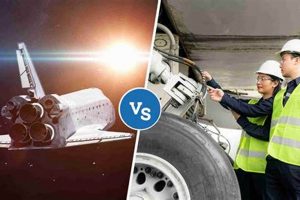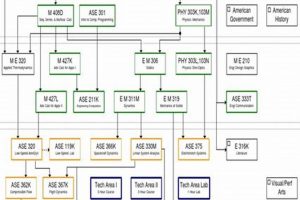The study of ionized gas behavior within the context of flight vehicle design and operation is a multifaceted field. It encompasses the investigation of how these gases interact with electromagnetic fields, aerodynamic forces, and material surfaces, particularly in conditions relevant to atmospheric entry, propulsion, and spacecraft environmental control. Understanding these interactions is crucial for developing novel technologies and enhancing existing aerospace systems.
This area of investigation offers significant advantages, including the potential for enhanced propulsion efficiency, improved thermal protection systems, and advanced communication capabilities. Historically, research in this field has been driven by the need to overcome challenges associated with hypersonic flight and space exploration. The insights gained contribute to safer and more effective space missions, as well as the development of advanced aircraft.
Subsequent sections of this article will delve into specific applications and areas of current research. These include topics such as plasma-based propulsion systems, magnetohydrodynamic control for hypersonic vehicles, and the use of ionized gases for shielding spacecraft from radiation and debris. Each of these aspects highlights the breadth and depth of this critical area of aerospace advancement.
Considerations for Applied Ionized Gas Studies in Flight Systems
This section provides key considerations for researchers and engineers working with ionized gas phenomena as applied to aerospace systems.
Tip 1: Accurately Model Plasma Properties. Computational models must accurately represent the thermodynamic and transport properties of ionized gases, including ionization fractions, electron temperature, and collision cross-sections. Failure to do so can lead to inaccurate predictions of plasma behavior and system performance. Utilize validated computational fluid dynamics (CFD) codes adapted for plasma simulations.
Tip 2: Prioritize Experimental Validation. Due to the complexity of plasma physics, numerical simulations should be validated with experimental data. Employ diagnostic techniques such as Langmuir probes, optical emission spectroscopy, and laser-induced fluorescence to characterize plasma parameters. Compare simulation results with experimental measurements to refine models and ensure accuracy.
Tip 3: Address Material Compatibility Concerns. Ionized gases can interact aggressively with material surfaces, leading to erosion, ablation, and changes in surface properties. Select materials carefully and investigate their response to plasma exposure under relevant conditions. Consider the use of protective coatings to mitigate material degradation.
Tip 4: Carefully Manage Electromagnetic Interference (EMI). Plasma generation and control often involve strong electromagnetic fields, which can interfere with onboard electronics. Implement shielding and grounding strategies to minimize EMI and ensure the reliable operation of critical systems. Conduct EMI testing to verify compliance with relevant standards.
Tip 5: Optimize Energy Efficiency. Plasma generation can be energy-intensive. Design systems to minimize energy consumption while achieving desired performance levels. Explore techniques such as pulsed power operation and magnetic confinement to improve energy efficiency.
Tip 6: Focus on Scalability and Integration. When developing plasma-based technologies, consider the challenges of scaling up laboratory prototypes to flight-ready systems. Address integration issues related to size, weight, power, and cooling. Develop robust control systems that can operate autonomously in harsh aerospace environments.
These considerations are crucial for the successful development and implementation of technologies utilizing ionized gases in aerospace applications. Careful attention to modeling, validation, material compatibility, EMI, energy efficiency, and system integration will help to ensure the reliable and effective operation of these advanced systems.
The subsequent sections will further explore the implications of these guidelines in specific aerospace applications.
1. Ionized Gas Behavior
The behavior of ionized gases is foundational to the field of plasma dynamics in aerospace engineering. Understanding the properties and interactions of these gases under varying conditions is critical for developing and optimizing various aerospace technologies.
- Thermodynamic Properties
The thermodynamic state of an ionized gas, characterized by parameters such as temperature, pressure, and density, directly influences its behavior. In aerospace applications, extreme conditions during atmospheric reentry or within plasma propulsion systems necessitate precise modeling of these properties. For example, the temperature of the plasma within a magnetoplasmadynamic thruster significantly affects the thrust efficiency and specific impulse.
- Electromagnetic Interactions
Ionized gases interact strongly with electric and magnetic fields. These interactions are central to controlling and manipulating plasma within aerospace devices. Magnetohydrodynamic control systems, for instance, exploit these electromagnetic forces to steer hypersonic vehicles or create plasma shields to protect spacecraft from radiation.
- Collision Dynamics
The frequency and nature of collisions between particles within an ionized gas impact its transport properties, such as thermal conductivity and electrical conductivity. Accurate modeling of collision processes is essential for predicting the behavior of plasmas in environments ranging from the Earth’s ionosphere to the plasma sheath surrounding a spacecraft. These collisions also influence the energy distribution within the plasma, affecting its radiative properties.
- Radiation Emission and Absorption
Ionized gases emit and absorb radiation across a wide spectrum, depending on their composition and temperature. This radiative behavior is significant for both diagnostic purposes and for thermal management. In atmospheric reentry, the radiation emitted by the hot plasma surrounding the vehicle is a primary source of heat flux, requiring careful design of thermal protection systems.
In summary, the behavior of ionized gases, dictated by their thermodynamic properties, electromagnetic interactions, collision dynamics, and radiative characteristics, is integral to plasma dynamics within aerospace engineering. Each aspect contributes uniquely to the performance and safety of aerospace systems, underlining the importance of comprehensive study and precise control of these complex phenomena.
2. Electromagnetic Interactions
Electromagnetic interactions constitute a fundamental aspect of plasma dynamics within the realm of aerospace engineering. The presence of charged particles within a plasma renders it highly susceptible to electromagnetic fields. These interactions are not merely incidental; they are integral to manipulating and controlling plasma behavior for various applications. For instance, magnetic fields can confine plasma, preventing it from directly contacting and damaging spacecraft components during propulsion or reentry scenarios. Conversely, electric fields can accelerate plasma particles to generate thrust in plasma propulsion systems. The efficacy of these control mechanisms hinges on a comprehensive understanding of the underlying electromagnetic principles and their application to plasma dynamics.
The consequences of electromagnetic interactions manifest in several aerospace technologies. In magnetohydrodynamic (MHD) power generation, the movement of plasma across a magnetic field induces an electric current. This principle is leveraged for energy conversion in certain spacecraft power systems. Furthermore, electromagnetic waves, particularly radio frequency (RF) waves, are used to heat plasmas in fusion propulsion concepts. The efficient absorption of RF energy by the plasma is contingent upon matching the wave frequency to the plasma’s resonant frequencies, a process deeply rooted in electromagnetic theory. In atmospheric reentry, the electromagnetic fields generated by the plasma sheath surrounding a vehicle significantly affect radio communication, necessitating specialized antennas and communication protocols to mitigate signal attenuation and distortion.
In conclusion, electromagnetic interactions are not simply phenomena observed within plasma; they represent a critical control mechanism and a defining characteristic of its behavior. Understanding and harnessing these interactions is paramount for advancing various aerospace technologies. Challenges remain in accurately modeling and predicting plasma behavior under complex electromagnetic conditions, especially in high-energy environments. Further research into these areas is crucial for the continued development of efficient and reliable plasma-based systems for aerospace applications.
3. Aerodynamic Forces
Aerodynamic forces are a critical consideration within the field of plasma dynamics for aerospace engineering. The interaction between moving air and a flight vehicle generates a complex interplay of pressure and shear stress distributions across the vehicle’s surface. Understanding and manipulating these forces are paramount for achieving stable and efficient flight, particularly in extreme conditions where plasma effects become significant.
- Drag Reduction via Plasma Actuation
Plasma actuators can be strategically placed on aerodynamic surfaces to modify the airflow near the surface. By creating localized regions of ionized gas, these actuators induce changes in the boundary layer, reducing skin friction drag and delaying flow separation. This is particularly relevant at high speeds where conventional aerodynamic control surfaces may become less effective. For example, plasma actuators have been demonstrated to reduce drag on airfoil surfaces, leading to improved fuel efficiency and enhanced maneuverability.
- Hypersonic Aerothermodynamics
At hypersonic speeds, the intense friction between the air and the vehicle generates extremely high temperatures, leading to the formation of a plasma sheath around the vehicle. This plasma significantly alters the aerodynamic characteristics of the vehicle. It modifies the pressure distribution and introduces new sources of heat flux to the vehicle surface. Accurate modeling of these aerothermodynamic effects is crucial for the design of thermal protection systems and for predicting vehicle performance during atmospheric reentry.
- Flow Control for Enhanced Maneuverability
Plasma actuators can also be used to actively control the flow field around a vehicle, enhancing its maneuverability. By selectively generating plasma regions, the flow can be redirected or stabilized, allowing for greater control authority at high angles of attack or during rapid maneuvers. This technology has potential applications in improving the agility of aircraft and spacecraft, enabling them to respond more effectively to changing conditions.
- Plasma-Based Aerodynamic Sensors
The interaction between aerodynamic forces and plasma can also be exploited for sensing purposes. Plasma-based sensors can detect changes in pressure, temperature, or velocity, providing real-time information about the flow field around a vehicle. These sensors can be integrated into flight control systems to improve the accuracy and responsiveness of aerodynamic control surfaces. Furthermore, they can be used for monitoring the performance of thermal protection systems during atmospheric reentry.
In summary, the interaction between aerodynamic forces and plasma dynamics is a complex and multifaceted area with significant implications for aerospace engineering. From drag reduction to flow control and sensing, plasma-based technologies offer innovative solutions for enhancing the performance and capabilities of flight vehicles. Continued research in this area is essential for advancing the state-of-the-art in aerospace technology.
4. Material Surface Impact
The interaction between ionized gases and material surfaces is a critical aspect of plasma dynamics within aerospace engineering. The impingement of plasma on various materials used in the construction of spacecraft, hypersonic vehicles, and propulsion systems leads to a range of effects, primarily erosion, ablation, and alteration of material properties. This impact is not merely a superficial concern; it directly affects the structural integrity, thermal management capabilities, and overall performance of aerospace vehicles. The energy and composition of the plasma dictate the severity of these effects, necessitating a thorough understanding of the underlying physical and chemical processes.
For example, during atmospheric reentry, the extreme heat generated by friction with the atmosphere creates a plasma sheath around the spacecraft. This plasma, composed of ionized atmospheric gases, bombards the thermal protection system (TPS) materials. The TPS materials, often ceramics or ablative composites, are designed to withstand this intense heat flux through ablation, a process where the material vaporizes and carries away heat. However, the rate and uniformity of ablation, as well as the chemical changes induced in the remaining material, directly influence the effectiveness of the TPS. Similarly, in plasma propulsion systems, the high-energy plasma plume interacts with the thruster walls, potentially leading to erosion and reduced thruster lifetime. The selection of appropriate materials and the optimization of thruster design are crucial to mitigate these effects.
In summary, material surface impact is an inseparable component of plasma dynamics in the context of aerospace applications. A comprehensive understanding of the plasma-material interaction is essential for designing durable and reliable aerospace systems. The challenges lie in accurately predicting the long-term effects of plasma exposure on various materials under diverse operational conditions. Addressing these challenges requires advanced material characterization techniques, sophisticated computational models, and rigorous experimental validation. This research is critical for enabling the continued advancement of plasma-based aerospace technologies.
5. Propulsion Enhancement
The application of plasma dynamics holds significant potential for enhancing aerospace propulsion systems. Traditional chemical rockets face limitations in terms of specific impulse and exhaust velocity. Utilizing plasma-based propulsion methods offers opportunities to overcome these constraints, enabling more efficient and high-performance spacecraft and aircraft.
- Magnetoplasmadynamic (MPD) Thrusters
MPD thrusters employ electromagnetic forces to accelerate ionized gas, generating thrust. These thrusters can achieve significantly higher exhaust velocities compared to chemical rockets, resulting in improved specific impulse. MPD thrusters have potential applications in deep-space missions, station-keeping, and orbit transfer maneuvers. Research focuses on increasing the efficiency and lifetime of MPD thrusters to make them viable for long-duration missions.
- Electrothermal Thrusters
Electrothermal thrusters utilize electric energy to heat a propellant, which is then expanded through a nozzle to produce thrust. These thrusters offer a balance between thrust and specific impulse, making them suitable for various in-space propulsion applications. Resistojets and arcjets are examples of electrothermal thrusters. Recent developments include the use of advanced materials and innovative nozzle designs to enhance performance and durability.
- Helicon Plasma Thrusters
Helicon plasma thrusters use radio-frequency waves to generate and heat plasma, which is then accelerated by a magnetic nozzle. These thrusters are characterized by high efficiency and high exhaust velocity, making them attractive for long-duration missions. Research is ongoing to optimize the plasma generation and acceleration processes to further improve thruster performance.
- Pulsed Plasma Thrusters (PPTs)
PPTs use short pulses of electric current to ablate and ionize a solid propellant, generating thrust. These thrusters are relatively simple and compact, making them suitable for small satellites and CubeSats. PPTs offer precise thrust control, enabling accurate orbit adjustments and attitude control. Research focuses on improving the energy efficiency and lifetime of PPTs to expand their range of applications.
In summary, plasma dynamics provides a diverse toolkit for enhancing aerospace propulsion capabilities. These technologies have the potential to revolutionize space exploration and satellite operations by enabling more efficient and high-performance propulsion systems. Continued research and development in this area are crucial for realizing the full potential of plasma-based propulsion.
Frequently Asked Questions
This section addresses common inquiries regarding the application of plasma dynamics in the aerospace engineering domain. The aim is to provide clear, concise, and technically sound answers to frequently posed questions.
Question 1: What are the primary challenges in applying plasma dynamics to aerospace engineering?
Challenges include the accurate modeling of complex plasma phenomena, the management of high temperatures associated with plasma generation, material compatibility issues due to plasma-surface interactions, and the integration of plasma-based systems within existing aerospace vehicle architectures.
Question 2: How does plasma dynamics contribute to improved aerospace propulsion systems?
Plasma dynamics enables the development of electric propulsion systems, such as MPD and Helicon thrusters, which offer higher specific impulse and exhaust velocities compared to conventional chemical rockets. This translates to more efficient and longer-duration space missions.
Question 3: Can plasma dynamics be utilized for spacecraft protection?
Yes, plasma shields can be generated to deflect charged particles from space radiation and micrometeoroids, thereby providing enhanced protection for spacecraft and their occupants.
Question 4: What role does computational modeling play in plasma dynamics research for aerospace applications?
Computational modeling is essential for simulating and predicting plasma behavior under various conditions. Validated computational fluid dynamics (CFD) codes are used to analyze plasma properties, electromagnetic interactions, and plasma-surface interactions, guiding the design and optimization of plasma-based aerospace systems.
Question 5: How does the presence of plasma affect radio communication during atmospheric reentry?
The plasma sheath surrounding a spacecraft during reentry can attenuate and distort radio signals, leading to communication blackouts. Mitigating these effects requires specialized antennas, signal processing techniques, and advanced communication protocols.
Question 6: What is the future outlook for plasma dynamics in aerospace engineering?
The future holds promise for further advancements in plasma-based propulsion, spacecraft protection, and flow control technologies. Ongoing research and development efforts are focused on improving the efficiency, reliability, and scalability of these systems, paving the way for their widespread adoption in future aerospace missions.
These answers provide a foundational understanding of the key aspects of plasma dynamics as it relates to aerospace engineering. Further exploration of specific topics can be found in the subsequent sections.
The following section presents a summary of the article’s key takeaways and conclusions.
Conclusion
The preceding discussion has illuminated various facets of plasma dynamics within the context of aerospace engineering. From its role in advanced propulsion systems to its potential for spacecraft protection and aerodynamic control, the influence of ionized gas behavior on aerospace technologies is undeniable. The intricacies of plasma-material interactions, the complexities of electromagnetic phenomena, and the challenges of accurate modeling all underscore the depth and breadth of this field. The exploration highlights the potential for transformative advancements in space exploration, hypersonic flight, and overall aerospace system performance through continued research and development in plasma dynamics.
Further investment in theoretical modeling, experimental validation, and materials science is essential for realizing the full potential of plasma dynamics in aerospace applications. The continued pursuit of innovation in this area promises to yield groundbreaking technologies that will shape the future of aerospace engineering. The challenges are significant, but the potential rewards are equally compelling, warranting sustained commitment and collaboration across disciplines.







